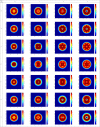Spatially dependent atom-photon entanglement
- PMID: 30218077
- PMCID: PMC6138718
- DOI: 10.1038/s41598-018-32051-8
Spatially dependent atom-photon entanglement
Abstract
The atom-photon entanglement using the Laguerre-Gaussian (LG) beams is studied in the closed-loop three-level V-type quantum systems. We consider two schemes with near-degenerate and non-degenerate upper levels: in the first, the effect of the quantum interference due to the spontaneous emission is taken into account and in the second, a microwave plane wave is applied to the upper levels transition. It is shown that the atom-photon entanglement in both schemes depends on the intensity profile as well as the orbital angular momentum (OAM) of the applied fields so that the various spatially dependent entanglement patterns can be generated by Laguerre-Gaussian beams with different OAMs. However, due to the zero intensity,no entanglement appears in the center of the optical vortex beams. As a result, the entanglement between dressed atom and its spontaneous emissions in different points of the atomic vapor cell can be controlled by the OAM of the applied fields. Moreover, our numerical results show that the number of the local maximum degree of entanglement (DEM) peaks depends on the OAM of the applied fields. The degrees of freedom for OAM play a crucial role in spatially dependent atom-photon entanglement in such a way that it may possess broad applications in high-dimensional quantum information processing and data storage.
Conflict of interest statement
The authors declare no competing interests.
Figures








Similar articles
-
Spatial-dependent quantum dot-photon entanglement via tunneling effect.Sci Rep. 2022 May 14;12(1):7984. doi: 10.1038/s41598-022-11810-8. Sci Rep. 2022. PMID: 35568700 Free PMC article.
-
Microwave-induced orbital angular momentum transfer.Sci Rep. 2019 Mar 5;9(1):3519. doi: 10.1038/s41598-019-40195-4. Sci Rep. 2019. PMID: 30837623 Free PMC article.
-
Orbital-Angular-Momentum Multiplexed Continuous-Variable Entanglement from Four-Wave Mixing in Hot Atomic Vapor.Phys Rev Lett. 2019 Aug 16;123(7):070506. doi: 10.1103/PhysRevLett.123.070506. Phys Rev Lett. 2019. PMID: 31491123
-
Enhancing and flattening multiplexed quantum entanglement by utilizing perfect vortex modes.Opt Lett. 2023 Apr 1;48(7):1782-1785. doi: 10.1364/OL.482249. Opt Lett. 2023. PMID: 37221765
-
Orbital angular momentum of photons and the entanglement of Laguerre-Gaussian modes.Philos Trans A Math Phys Eng Sci. 2017 Feb 28;375(2087):20150442. doi: 10.1098/rsta.2015.0442. Philos Trans A Math Phys Eng Sci. 2017. PMID: 28069773 Free PMC article. Review.
Cited by
-
Spatial-dependent quantum dot-photon entanglement via tunneling effect.Sci Rep. 2022 May 14;12(1):7984. doi: 10.1038/s41598-022-11810-8. Sci Rep. 2022. PMID: 35568700 Free PMC article.
-
Laguerre-Gaussian modes generated vector beam via nonlinear magneto-optical rotation.Sci Rep. 2021 Mar 16;11(1):5972. doi: 10.1038/s41598-021-85249-8. Sci Rep. 2021. PMID: 33727617 Free PMC article.
-
Microwave-induced orbital angular momentum transfer.Sci Rep. 2019 Mar 5;9(1):3519. doi: 10.1038/s41598-019-40195-4. Sci Rep. 2019. PMID: 30837623 Free PMC article.
References
-
- Horodecki R, Horodecki P, Horodecki M, Horodecki K. Quantum entanglement. Rev. Mod. Phys. 2009;81:865–942. doi: 10.1103/RevModPhys.81.865. - DOI
-
- Ficek, Z. & Swain, S. Quantum Coherence and Interference; Theory and Experiments (Springer, 2004).
-
- Freedman SJ, Clauser JF. Experimental test of local hidden variables theories. Phys. Rev. Lett. 1972;28:938–941. doi: 10.1103/PhysRevLett.28.938. - DOI
LinkOut - more resources
Full Text Sources
Other Literature Sources
Research Materials

